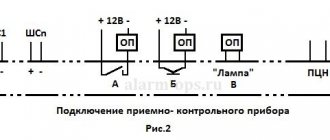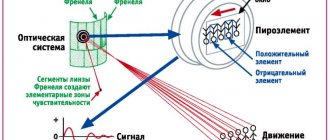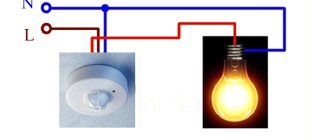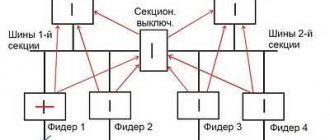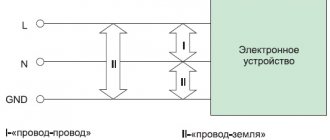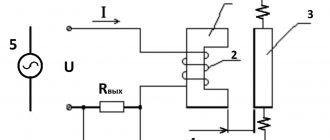Motion detectors are the basis of a security system; their type and technical characteristics determine the level of its effectiveness and the complexity of unauthorized entry.
The most common detectors used in alarm systems are passive infrared motion sensors.
Their main function is volumetric control of the protected space of the entire room.
Operation principle and conditions
The device records the dynamics of changes in the thermal radiation of the object and the general background. Monitoring is carried out over a certain period of time.
To trigger, certain conditions must be met. Firstly, a change in the position of the object in space controlled by the detector.
Secondly, the trajectory must be perpendicular to the direction of the IR radiation generated by the device.
Thirdly, the distance from the radiation source must be sufficient for its level of perception, that is, it must determine the temperature difference between the object (including clothing) and the surrounding background.
What to look for when choosing a sensor?
An infrared motion sensor is purchased taking into account its installation location. When installing indoors, some characteristics should be taken into account, and when installing outdoors, others.
If the device monitors the local area, its parameters will be presented:
- Operating temperature range.
- Availability of anti-sabotage functionality.
- Sensor protection class.
- The quality of device settings.
The temperature range of the IR sensor should be from -35 to +50 degrees, with 100% relative humidity. The protection class of such a device must be at least IP55. The sensor must be configured in such a way that it only reacts when people approach the area. The system should not take into account animals, birds, vehicles and other moving objects. An important factor is protection from damage. If there is an anti-sabotage system, damage to the sensor can be determined by the signals it sends to the central unit.
For an enclosed space, the temperature range should be small, but when purchasing a device for this device, it is important to determine the detection zone, which can be volumetric, superficial and linear.
Sensitivity
The main scanning element of the device, the pyro-receiver, has a dual structure, and therefore a pair splitting of each beam occurs in the radiation plane.
Based on the structural features of different models of infrared motion sensors, the sensitivity zones of different models may have different configurations. These can be pinpoint beams aimed at a small angular segment, forming a distant detection point.
Several such beams located on a horizontal or vertical plane form a “vertical barrier” or “scanning surface”; it can be horizontal or inclined.
A single wide beam emitted in a horizontal or vertical plane forms a “scanning curtain”.
Mobile video surveillance can transmit data via Wi-Fi, GSM, 3G and 4G networks or CDMA. In this case, the key parameter affecting the efficiency of the system is the speed of access to the Internet.The signal transmitted by the cameras is encoded and converted into one of the formats supported by the device. After which it is recorded to the HDD disk. Read more about the CCTV recording system here.
In addition, the intensity of the generated radiation affects the length of the scanned response zone. The viewing sector can range from 300 to 1800 for wall-mounted detectors and the circular sector can be 3600 for ceiling models. It is also possible to regulate the number of rays and their angle of inclination, up to 900.
This diversity is due to the requirements for operation in various conditions and a high level of efficiency, which must ensure uniform sensitivity of the detector throughout the protected response volume.
How the device works
The security passive infrared motion sensor includes the following components:
- Optics (curved mirror elements or Fresnel lenses).
- Sensing elements placed in a sealed housing.
Depending on the type of optical system, reflection or focusing of human infrared radiation occurs. Most often, sensors equipped with Fresnel lenses are used, since they are low cost and easy to manufacture.
Structurally, such a sensor is a flat plate with lenses of different thicknesses on the surface. These elements allow you to focus the infrared beam on each of the areas that have increased sensitivity.
There are also infrared motion sensors equipped with a spherical optical system. They are mounted in passive devices, which are often located in the ceiling area.
Optical elements
The sensitivity of the detector depends on the percentage of beam area overlap. Accordingly, at a distance of 15-20 m, to detect an object the size of a person, a beam with a width of no more than 100 is required.
But when approaching the device, the level of sensitivity will increase, and from a distance of 5 m an ordinary mouse can raise the alarm.
To distribute the uniformity of sensitive zones, optical elements form several sectors of radiation with different widths and directions at different angles. The device itself, as a rule, is mounted slightly higher than human height.
Consequently, the entire volume of the detection zone is divided into several sectors, with varying degrees of sensitivity of the beams, selected in such a way that the overall sensitivity of the device does not change as it moves away or approaches it.
The problem of uniform sensitivity of passive IR motion sensors is solved with the help of optical diffusers.
| Fresnel lens - This is a polymer plate or hemisphere, on the surface of which prismatic lenses are stamped entirely or segmentally. This element is used in most models, as it has a number of advantages, including:
| |
| Mirror optics - uses a rather complex system of mirrors with a special coating (black mirror), the segments are located at different angles to cover different focal lengths. |
Such a system can be tuned more precisely, which makes it possible to increase its sensitivity at long distances by up to 60%. In addition, the segment structure makes it easier to configure protection for the near “sabotage” zone.
The use of triplex technology in mirrors allows the use of infrared motion sensors in rooms where there are pets.
Modern high-performance models use a combination of both systems, where the Fresnel lens controls the middle zone, and mirror optics devices control long-range approaches and the sabotage zone.
Microwave (MW) motion sensors
Operating principle of a microwave motion sensor
A microwave motion sensor emits high-frequency electromagnetic waves (the wave frequency may vary depending on the manufacturer, usually it is 5.8 GHz), which, when reflected from surrounding objects, are registered by the sensor and if the slightest changes in the reflected electromagnetic waves are detected, the microprocessor of the device activates the built-in his function.
How does a microwave motion sensor work?
The operation of an ultrasonic motion sensor is in many ways similar to the ultrasonic motion sensor described above and is based on the interaction of microwave waves with the material and the use of the Doppler effect - a change in the frequency of the wave reflected from moving objects. The very name “microwave” suggests that it operates in the ultrahigh frequency range, its wavelength in the approximate range of one millimeter to one meter.
When a moving current-conducting object appears in the detection zone of a microwave motion sensor, it registers it and immediately sends a signal to perform the function built into it.
The main disadvantages of ultrasonic motion sensors:
— Has a higher cost compared to other types of sensors with similar performance
— Possibility of false alarms due to movements outside the required observation area, outside the window, etc.
— Microwave radiation is unsafe for human health, it is necessary to choose microwave motion sensors with low radiation power. According to the conclusions of organizations studying the effects of microwave radiation on the human body (World Health Organization, International Commission on Non-Ionizing Radiation Protection and some others), continuous radiation with a power density of up to 1 mW/cm2 is safe for humans.
Advantages of microwave motion sensors:
— The sensor is capable of detecting objects behind a variety of dielectric or weakly conductive obstacles: thin walls, doors, glass, etc.
— The performance of the sensor does not depend on the temperature of the environment or objects
— Microwave motion sensor is able to respond to the slightest movements of an object
— The sensor has a more compact size
— Can have several independent detection zones
Pyro receiver and interference
A pyroelectric transducer is a semiconductor device that is capable of detecting temperature differences and converting it into an electrical impulse.
Such sensors use pairs, and in some models two pairs of pyroelectric elements. This allows you to reduce the number of false alarms that are caused by a simple increase in room temperature.
In paired pyroelectric detectors, operation occurs only when one of the beams intersects; processing occurs using a differential algorithm, subtracting the signal of one pyroelectric element from the signal of the other.
The main types of interference that can cause false alarms of built-in IR motion sensors:
- insects caught inside or on the sensor housing;
- Pets;
- vibrations and shocks;
- radio and electromagnetic interference;
- directional and bright light sources;
- air conditioners, batteries, thermal curtains and other climate control equipment;
- partial reflection of IR rays from the inner surface of the device;
- heating of the internal parts of the detector.
Popular models of infrared motion sensors
When choosing an IR motion sensor, you must consider the following parameters presented:
- Scope of application.
- The angle of perception of the device.
- Purpose of installation.
- Configuration of the controlled area.
- Precise timing adjustment.
- Manufacturer of the device.
The most popular sensors are:
- Flash-SRP600, LC100.
- Swift P-314.
- PIR-3SP.
The first two emitters on the list do not react to pets weighing up to 25 kilograms. They also belong to the category of combined ones, which makes them the most popular among others. These sensors only send a signal to the remote control if they detect a moving object over a specified mass. They are installed in security systems that respond to intrusion. Emitters are used both to protect homes and industrial premises.
Their advantages are presented:
- Easy to install.
- Modern design.
- Possibility of outdoor placement.
- Supported by all units of the central security system.
Wireless models of IR sensors include PIR-3SP. Like the previous two, he does not react to the presence of animals in the room. The circuit used for its manufacture allows signals to be processed using a microprocessor, which provides additional verification. This device can be used to protect any objects.
Its advantages are presented:
- By sending test signals to the central unit.
- Informing about battery charge.
- Using an encryption protocol using floating code.
Processing block
An analog, digital or combined device that processes signals received from the receiver in order to isolate the impulse caused by the intruder from the general stream of interference.
The processing algorithm is based on the analysis of the shape, duration and magnitude of the signal. The signal from the human figure is symmetrical and bipolar, in contrast to noise asymmetrical signals.
The signal magnitude is the main parameter by which the incoming pulse is analyzed.
In inexpensive BO models, only it is analyzed, compared with a threshold indicator and counting the number of operations. After exceeding a certain number per unit of time, an alarm is triggered.
This method is imperfect and leads to a large number of false alarms from vibrations or electromagnetic interference.
If you set a low sensitivity, then in sensors with a “single curtain” type control zone, there may be no response at all if only one beam is crossed.
More expensive sensors additionally analyze the polarity and symmetry of the incoming signal shape.
Methods for protecting motion detectors from interference
Special light-filtering plastic of the external lenses allows you to protect the pyroelectric element from white light; to protect against insects, a sealed chamber is mounted between the pyroelectric element and the lens.
Some detector models have a special lens with a dead zone of up to 1 m from the floor, which is quite enough for small pets. Shielding is used to protect against electromagnetic interference.
The most effective methods of protection against false alarms lie in the correct sensitivity setting and external signal processing algorithms.
One of these functions is temperature compensation, which automatically increases the sensitivity of the sensor when the ambient temperature is in the range of 25-350C. Additionally, an anti-masking function is used, which warns of the surface of the sensor lens being sealed.
You can organize security and control in parking lots, car washes, service stations and gas stations using video surveillance, and a specialized access control system will help control personnel fraud, reduce costs and, as a result, significantly increase profits.The direction of development of new video surveillance systems is the use of technologies that allow expanding the shooting angle. Read more about new video surveillance systems in this article.
Also, almost all modern models are equipped with a tamper relay, which signals if the device has been tampered with.
Ultrasonic (US) motion sensors
Operating principle of ultrasonic motion sensor
The operating principle of an ultrasonic motion sensor is to study the surrounding space using sound waves with a frequency beyond the audibility of the human ear - ultrasound. When a change in the frequency of the reflected signal is detected, as a result of the movement of objects, the sensor launches the function embedded in it.
How does an ultrasonic motion sensor work?
Inside the ultrasonic motion sensor there is a generator of sound waves (depending on the manufacturer and model, a sound wave frequency of 20-60 kHz is usually generated), which are emitted in the sensor’s coverage area and, reflected from surrounding objects, come back to the receiver.
When a moving object appears in the detection zone of an ultrasonic motion sensor, the frequency of the wave reflected from the object changes (Doppler effect), which is registered by the sensor receiver and a signal is received from it to perform the function inherent in the ultrasonic motion sensor, this could be turning on the lighting or breaking the security alarm network systems.
Ultrasonic motion sensors are particularly widely used in the automotive industry: in automatic parking systems, in so-called “parking sensors”, as well as in blind spot monitoring systems. In the house they perform well in detecting movements in fairly long corridors, on stairs, etc.
The main disadvantages of ultrasonic motion sensors:
— Many pets hear the ultrasonic frequencies at which the motion sensor operates, which often causes them severe discomfort
— Relatively short range
— It only triggers on fairly sudden movements; if you move very smoothly, it is possible to fool the ultrasonic motion sensor
Advantages of ultrasonic motion sensors:
— Relatively low cost
— Not affected by the environment
— Detect movement regardless of the material of the object
— Have high performance in conditions of high humidity or dust
— Do not depend on the influence of ambient temperature or objects





